Tips on How to Write Better Melodies
What is a melody and why is it important? Learn how to create both effective and memorable melodies. This guide will help you develop your melody writing skills.

What is a Melody?
Melody is a rhythmical sequence of notes that create a musical phrase or motif. A melody also consists of two parts: pitch and rhythm. We sometimes think of melodies as the vocal part of a song. However, a melody can also be the topline of your instrumental drop, a signature bassline, or even a unique vocal sample.
Melody also plays a significant role in our experience of a song’s emotion, structure, groove, and personality. Have you ever had a song stuck in your head for hours or even days? What part do you singe repeatedly? Have you ever been to a show where everyone sings along together to a particular part of the song? That’s the melody!
Why are Melodies Important?
Why do we want strong melodies in our music? Because an effective melody is what listeners sing along to, relate to, and remember. They are the most memorable part of a song. Also, your melodic material is often the primary focus or central element of your music.
Listen to a few of your favorite songs and pinpoint the melody part that is memorable. These melodies play an essential role in shaping the character originality of your song. The groove, sound design, effects, and sample choices are also invaluable in setting the vibe. However, they all create a foundation that supports your melody.
How to Identify a Weak Melody
To define what a strong melody is, let’s first look at identifying weak melodies. Weak melodies lack a sense of signature or personality. They’re not memorable and don’t grab a listener’s attention.
Moreover, ineffective melodies lack repetition and structure. Humans like patterns in music. We like similarity because it feels familiar and gives us a sense of something we can latch onto. A melody without repetition or structure is similar to a story with no purpose or direction. There’s no sense of where ideas start, begin, or relate to each other.
Melodies can also become boring or redundant if you don’t create variation. For example, repeating the same idea becomes predictable. It also drains the excitement or interest from the listening experience.
A poorly written melody can also lack space or structure. We need spaces and breaks to “chunk” ideas together and process what we just heard. Avoid making your music sound like a run-on sentence or someone who talks without breathing. This can result in melodic ideas that lack purpose, drive, and memorability.
How to Write Strong Melodies
What are the elements of a strong melody? Melodies can be broken down to smaller ideas called motifs. Motifs are shorter melodic ideas that use different pitches in rhythm. Let’s look at these two variables and analyze how we can utilize them to our advantage.
Melody and Pitch
Pitch is how high or low a note sounds. A melody comprises high and low-pitched notes played one after the other. Pitch also makes a melody singable and memorable. You can control pitch by placing notes along the vertical MIDI grid in your DAW.
Improve the way pitch influences your melodies with these tips:
1. Use Stepwise Motion
The most compelling melodies combine stepwise motion and leaps. Stepwise motion is moving from one note to the next up or down in the scale.
Stepwise makes it easier for the listener to follow because the notes rise and fall smoothly in either full or half step intervals. It also makes it easier to play melodies without jumping between large intervals. For example, the key of C has the notes C, D, E, F, G, A, B. If your melody starts on an E, move up a step to an F or down a step to a D.
The song “Yesterday” by The Beatles uses stepwise motion effectively. The melody walks up and down the scale with very few leaps. That’s why it’s easy to remember and sing along too.
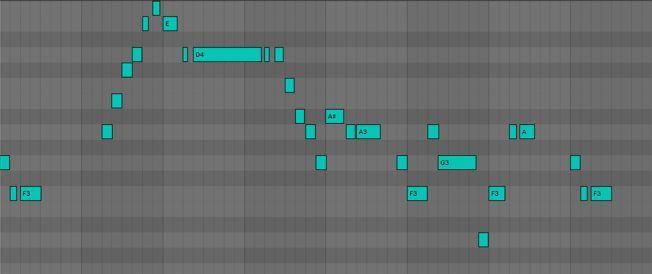
2. Use Leap Motion
Leap motion is when the melody rises and falls with large intervals between one note and the next. For example, the interval from C to F is a leap.
Melodic leaps often grab a listeners interest. Melodies with few or no leaps can become boring because the stepwise motion is somewhat predictable. However, leaps should be very intentional and used with caution. This motion is considered a disjunct melody and is less smooth sounding. Also, too many leaps are difficult to process and sing along too.
The song “Somewhere Over the Rainbow” has an octave leap up followed by a downward stepwise motion resolution. This large leap makes the initial melodic statement memorable. However, it doesn’t have a sense of balance and makes the melody hard to sing.
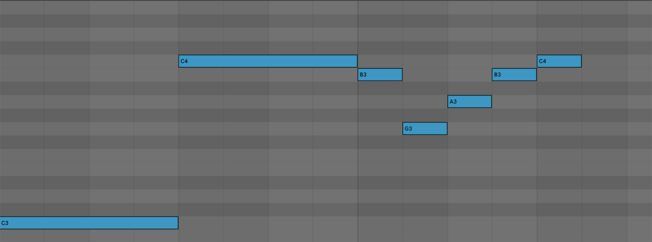
3. Place Melody Notes on Chord Tones
Using the notes from chords is an effective way to maintain harmony. Placing melody notes on chord notes also emphasizes those chords.
For example, an A minor triad chord has the notes A, C, E. These are the 1st, 3rd, and 5th notes from the root within the scale. Using the notes, A, C, and E over an A minor chord will sound harmonic, smooth, and conjunct. Conversely, placing melody notes outside of the chord notes will sound confusing, unbalanced, and disjunct.
The verse of “Nocturnal” by Disclosure and The Weeknd uses notes from the chords to create the melody. The notes emphasized are D, F, and A over the chords G Minor and D Minor.
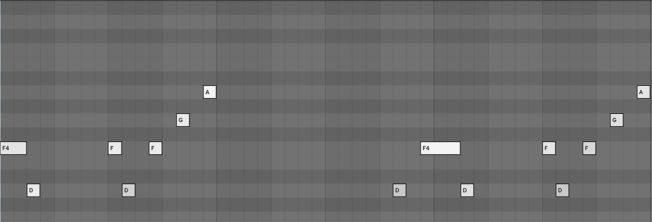
4. Use the Pentatonic Scale
The Pentatonic scale is a five-note scale derived from either a major or minor scale.
- A major pentatonic scale removes the 4th and 7th scale degrees of the major scale. For example, a C major pentatonic scale has the notes C, D, E, G, A.
- A minor pentatonic scale removes the 2nd and 6th scale degrees of the minor scale. For example, an A minor pentatonic scale has the notes A, C, D, E, G.
Pentatonic melodies have several advantages. For instance, they offer increased chord progression choices, are easy to create and sing, and sound harmonically pleasing. Other scale degrees sound great as well. However, pentatonic scales are a solid place to start.
The song “Psycho” by Post Malone uses a simple melodic motif that hits the chord tones of the G# major pentatonic scale. But it also uses other notes outside the chords. This combination keeps the melody interesting while also making it sound correct over the chords.

Melody and Rhythm
When writing melodies and motifs, it’s also essential to focus on rhythm. The rhythmic succession of notes gives your melodies groove, vibe, and character. You can control rhythm by placing notes along the horizontal MIDI grid in your DAW.
Improve the way rhythm influences your melodies with these tips:
1. Use Syncopation
Syncopation varies notes in a pattern that deviate from a regular expected rhythmic pattern. Without syncopation, your music can become repetitive and monotonous.
A syncopated rhythm will often use 8th and 16th note patterns. This method also places stress on weaker upbeats. This contrasts with placing notes on the “strong” or predictable downbeat of the quarter note.
2. Add Rhythmic Variation
The most memorable melodic and rhythmic motifs often switch between notes on the beat and syncopated notes. Rhythmic variation creates a sense of tension and release. For instance, the listener is drawn in by the syncopation and returned to a stable place with an emphasis on strong beats. This push and pull rhythm between the straight and syncopated notes feel comfortable and intriguing.
The verse of “Quarrel” by Moses Sumney uses syncopated notes followed by straight rhythms. This pattern also resolves the rhythmic tension of the off-beats at the beginning of the melody.
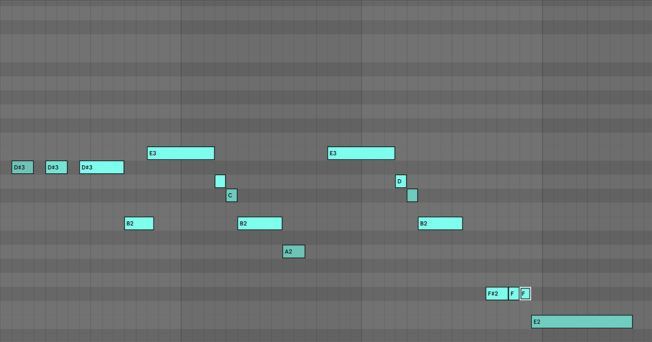
3. Combine Long and Short Notes
Combining long “Legato” notes and short “Staccato” notes give melodies a different emotional impact.
The verse melody of “PYT” by Michael Jackson uses a simple rhythmic motif that hits long notes and short rhythmic notes. This method keeps the melody interesting. It also makes it sound correct over the chords.
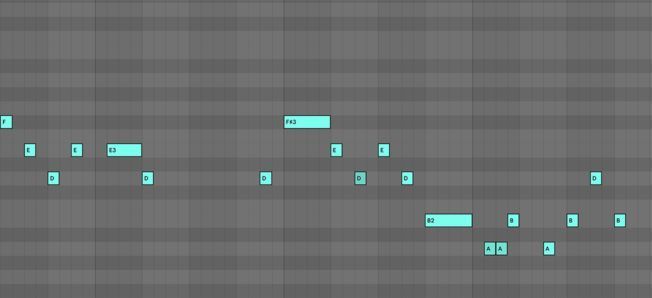
More Melody Writing Tips
What are the next steps? How do we put all these ideas together? And how do we create variation between sections using pitch and rhythm? Try these tips:
1. Use Call and Response
Good melodies feel effortless, like conversation or speech. Think of a melodic idea like a question and answer. Or, like the call and response of conversation.
A call and response succession creates musical tension and release. It consists of two distinct phrases. For example, a call phrase starts the melody like a question. Then the response phrase follows with a different, more conclusive resolution.
Analyzing phrase structures like ABAC or AABA is a helpful way to recognize melody creation. For example, the chorus of “Into You” by Ariana Grande uses the ABAC structure.
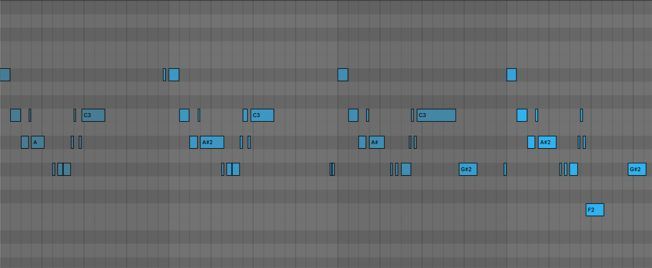
2. Creating Variation
Keep your melodies interesting by creating variation between the different sections of the song. For example, add slight changes to the melody in the intro, verse, chorus, breakdown, etc. to keep things interesting. Here are ideas that add variation:
- Give each section its own motif. A motif is a short musical idea that occurs often in a piece of music. They are shorter than a phrase.
- Start the melody on different beats. One section could start on the downbeat, while another section comes in after the downbeat.
- Start on different notes. One section could start with the root note, and the next section could start on the 5th (7 semitones higher). Also note, the highest pitch is often the melodic climax of intensity.
The song “Don’t Wanna Fight” by Alabama Shakes has a steady melodic rise between the verse, pre-chorus, and chorus.
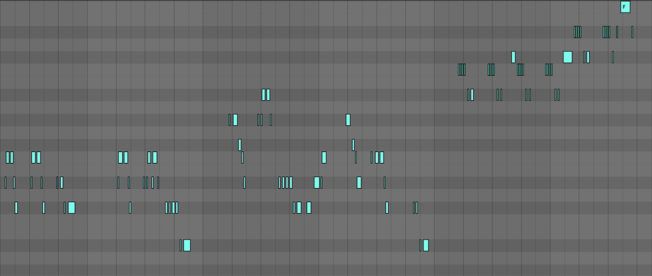
How to Find Melody Inspiration
Here are some other great melody techniques that will help you create strong and compelling melodies:
- We often sing with natural phrasing both rhythmically and melodically. That’s because we’ve been listening to music for our entire lives. Tap into those instincts by recording yourself on your phone. Try singing ideas whenever inspiration strikes and record them. In addition, Ableton Live offers Audio to MIDI conversion features. They will transform your recordings into MIDI that can be edited to create melodies.
- Try writing melodies with other musicians, singers, and producers. Sing melodic or rhythmic ideas together and record them. You might create something you would never have made on your own.
- Transcribe rhythms and melodies from songs you like. Figure out what melodies, rhythms, and notes work well in other songs. This method will help you improve your melodic instincts. You can even borrow melodies from other music producers and edit them to work with your songs.
- Clap or play a rhythm into your DAW over a tempo or groove. Then move the captured audio around on the grid to create rhythmic variations. Each placement will shift the emphasis to another beat and give it a different groove. You can also try these rhythms over different tempos and assign different notes to give it some pitch variation.
Conclusion
Improve your melody skills by practicing writing melodies often and regularly. Challenge yourself to write 3-4 melodies a day for a week. Or, write several melodies over a particular loop or chord progression. Just like a muscle, your melodic senses and instincts will improve when you use them frequently.



